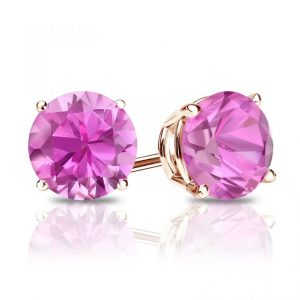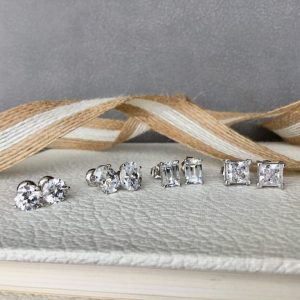Bezel settings and prong settings are both excellent choices for your fine jewelry, but they’re quite different. They’re not only different in style, but also in practicality and durability, so people often prefer one over the other.
If you’re wondering whether you should choose a bezel setting or a prong setting, this guide is for you. Below, we’re going over everything you need to know about bezel vs prong settings, including the pros and cons of each setting style.
Understanding Settings
Before we break down the differences between bezel and prong settings, we’ll give a general overview of jewelry settings for anyone who’s unfamiliar with them.
Jewelry settings, also called jewelry mountings, are what hold gemstones in place on jewelry. The two most common settings for larger gemstones are prong and bezel settings. Other large stone settings include halo settings and tension settings. Some popular side stone settings are pavé settings and channel settings, which are often used to set gemstones on engagement ring shanks (bands) and wedding bands.
The term “setting” can be confusing if you’re new to fine jewelry terminology since it’s used as the name for both gemstone mountings and complete jewelry designs that can be set with gemstones. For example, say you have a prong-set solitaire diamond engagement ring. The prong setting that holds your center diamond in place is called a setting, but the entire ring design minus your center stone is also called a setting. For the sake of clarity, we’ll only be talking about the gemstone mounting type of setting in the rest of this article.
What is a Bezel Setting?

A bezel setting holds gemstones in place with a strip of metal that has been bent into the shape of the gemstone. This type of setting acts as a metal rim that encloses the sides of the top of the gemstone. If that gemstone is round, the bezel setting will be a metal circle. If the gemstone is fancy-shaped, its bezel setting will echo its shape, whether it’s oval-shaped, Asscher cut, marquise cut, and so on.
Full bezel settings, which fully surround a stone, are the most common type of bezel setting. But there are variations of this type of setting, such as half-bezel settings. Half bezel settings are partial bezels that enclose two sides of a stone rather than the entire gem.
What is a Prong Setting?

A prong setting holds gemstones in place with tiny prongs of metal that curve around the stone. The tip of these prongs can vary in shape. Prongs most often feature round, squared or pointed tips. V-shaped prongs are also used on certain pointed fancy gemstone shapes, including marquise cut, pear-shaped, and heart-shaped gemstones.
Standard prong settings usually feature four prongs, but three-prong and six-prong settings are also common. Both four-prong and six-prong settings are extremely popular for engagement rings. Another common prong style is the double prong, which features pairs of prongs instead of single prongs.
Pros and Cons of Bezel Settings

Pros
Perhaps the biggest advantage of bezel settings is their high level of protection and durability. Bezel settings completely surround the edges of a gemstone, which offers excellent protection against chipping and other types of damage. This makes bezel settings a great option for anyone with an active lifestyle. It also makes bezel settings a wonderful choice for more fragile gemstones.
In addition to being protective, bezel settings are low maintenance. Because they don’t loosen easily, they don’t need to be checked by a jeweler as often as prong settings. Bezel settings can also hide some gemstone flaws. Since bezel settings cover the edges of a gemstone, they can hide inclusions and blemishes along these edges.
Cons
The main disadvantage of bezel settings is that they allow for less light entry compared to prong settings. This isn’t necessarily an issue if you’re choosing a setting for colored gemstone jewelry, but some would consider it a con for diamond jewelry. When less light enters a diamond, less can exit, so the same diamond may look slightly less sparkly in a bezel setting than it would in a prong setting.
Another potential disadvantage of bezel settings is that there’s less design selection and flexibility compared to prong settings. Prong settings are more popular than bezel settings, so there are more prong set jewelry designs to choose from. Bezel settings also tend to predominantly exist for round diamond and gemstone jewelry, whereas prong settings are used for every diamond and gemstone shape. Bezel settings can be made in any shape, but fancy-shaped bezels are significantly less common compared to prongs.
Pros and Cons of Prong Settings

Pros
The main advantage of prong settings is that they cover very little of their enclosed gemstones, allowing for a large amount of light entry. This is particularly important for diamonds since it ensures they sparkle to their maximum capacity. Because of this, prong diamond settings are extremely popular for all types of diamond jewelry, especially diamond studs and diamond rings.
Other advantages of prong settings include style variety and adaptability. Prong settings are the most popular setting style and can be found in a huge array of design styles. There are countless prong set earring, necklace, bracelet, fashion ring, and engagement ring styles for you to choose from. Thanks to their flexibility, prong settings are also able to enclose all gemstone and diamond shapes. Prong settings are an option no matter which shape you prefer.
Cons
The main disadvantage of prong settings is their lower protection and durability. Prong settings don’t offer as much protection as bezel settings. They’re also more easily displaced, so they should be regularly checked by a jeweler. It’s best to have frequently worn prong set jewelry checked by a jeweler every six months to a year to ensure the settings are secure.
Another disadvantage of prong settings is the fact that they can snag on things like clothing and blankets. This is less of an issue for prong set earrings and necklaces than it is for prong set rings and bracelets. Prong-set rings can be particularly irritating or inconvenient for those who work with their hands.
Bezel vs Prong Settings: Which Should You Choose?
Whether you prefer bezel or prong settings all comes down to personal preference. If you want a durable, sleek, and practical setting, bezel settings may be best for you. If you want maximum sparkle and lots of style options, prong settings may be the right choice for you.
It’s worth pointing out that you may prefer bezel settings for one type of jewelry, but prong settings for another. For instance, if you often work with your hands, you may want a bezel ring setting that will work for your active lifestyle. But if you like the look of prong settings, they could still be a good fit for something like diamond stud earrings, which are much less likely to snag or get bumped compared to a ring.
If you’re still wondering which of these setting styles is right for you, browse our customizable diamond jewelry and try out different setting, diamond shape, carat weight, and precious metal combinations.







 1-855-969-7883
1-855-969-7883 info@diamondstuds.com
info@diamondstuds.com










